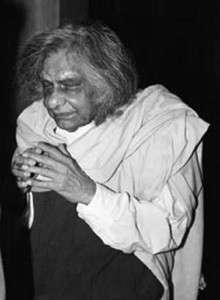Compiled by Esther Warkov
Book and CD $29.95
305 pp. soft cover 2010
Compendium Publications, Seattle
www.compendiumpublications.com
Phone 206-659-0038
Review by John Schlenck
Esther Warkov has rendered a signal service to the Ramakrishna Vedanta community, not only in America but worldwide, by assembling more than 60 remembrances of one of the great swamis of the second generation of our movement – those who knew Sri Sarada Devi and the direct disciples of Sri Ramakrishna. We in America are indeed fortunate that so many of these monks were sent here to give spiritual guidance. They have been a living link to the founders of the movement.

Swami Aseshananda
As a book of reminiscences, Remembering Sri Sarada Devi’s Disciple does not claim to be a biography of Swami Aseshananda. But what it gives us is a living sense of the Swami as he touched and transformed the lives of those who came to him. In their immediacy and variety, these reminiscences provide a rounded, multi-textured portrait of the swami; in their remarkable candor and directness, they bring us a genuine, living person, not an edited, air-brushed saint. The endearing human qualities and eccentricities are all there, along with deep spirituality and inspired teaching. Swami Vivekananda once expressed a desire to know more details about the life of Jesus, feeling that would be more valuable than all his “long sermons.” We are fortunate now to have this kind of detail in the life of Swami Aseshananda, not so speak of the lives of Sri Ramakrishna, Holy Mother, Swami Vivekananda and some of their direct disciples.
The contributors to this volume are quite varied: two senior Indian swamis, several American swamis and pravrajikas, long-time devotees and disciples, those who knew Swami Aseshananda for shorter periods of time, and a few who knew him when they were children. Though most of them knew the swami during his long ministry in Portland, there is a reminiscence of him as head of the Ramakrishna Mission Students’ Home in Madras, and another of him as Assistant Minister and novice master in Southern California before he was appointed to the Portland Center.
Through these detailed accounts, one also gains a larger picture of Swami Aseshananda. His life was a remarkable blend of jnana, bhakti and karma-yoga. His public teaching was largely on Advaita Vedanta, and he encouraged aspirants inclined toward nondualism to follow that path. At the same time, his devotion to Sarada Devi, his teacher, and to Sri Ramakrishna, was intense and profoundly moving. One could see this in the way he bowed down in the shrine at the Portland Center. I was privileged to see this during a three-day visit nearly forty years ago. He seemed to melt into the floor. This is also said to be true of Swami Saradananda as he bowed down to Holy Mother during her lifetime.
Indeed, the example and love of Swami Saradananda exerted probably the strongest influence on Swami Aseshananda’s life. Aseshananda served as his private secretary for a number of years. An American nun once asked Aseshananda, “Swami, when one is in terrible, terrible difficulties, who or what do you think about?” After a moment’s pause the swami replied, “I think of Sri Ramakrishna, Swami Vivekananda, and Holy Mother. These are our gurus.” But the nun, not satisfied, pressed on: “I mean when you are really, really in trouble.” The Swami replied without hesitation, “I think of Swami Saradananda, the swami who trained me. He was the person who spoke to all my difficulties, he was the person that I saw within myself and could talk to very openly.” (p. 20)
The karma-yoga aspect was also very strong. His unremitting dedication and service were seen not only through his spiritual teaching but also through physical exertion. He continued to mow the Center lawn well into his old age, and personally accompanied visiting devotees on car trips to the Society’s rural retreat and to other places of interest in Portland and vicinity.
Remembering Sri Sarada Devi’s Disciple is attractively produced, with good quality paper and large enough print to avoid eyestrain. Four striking photographs of Swami Aseshananda adorn the cover, and a large number of photographs are given on the accompanying compact disk. Also included on the disk are facsimiles of the swami’s handwritten letters, two video segments of the swami being interviewed, and The Lotus and the Flame, a record of the swami’s teachings to young monks at the Ramakrishna Monastery in Trabuco California by Swami Yogeshananda. One minor inconvenience is the absence of page numbers in the table of contents. One has to thumb through to find the desired reminiscence.
I strongly recommend this book for its vivid presentation of a modern saint who lived and taught among us for many valuable years.
JOHN SCHLENCK, a composer of music, is Associate Editor of American Vedantist and Secretary-Treasurer of Vedanta West Communications. He is a resident member and Secretary of the Vedanta Society of New York.

The author is compiling additional reminiscences for an updated online version of this collection. Please contact her at books@compendiumpublications.com or 520 789-7704